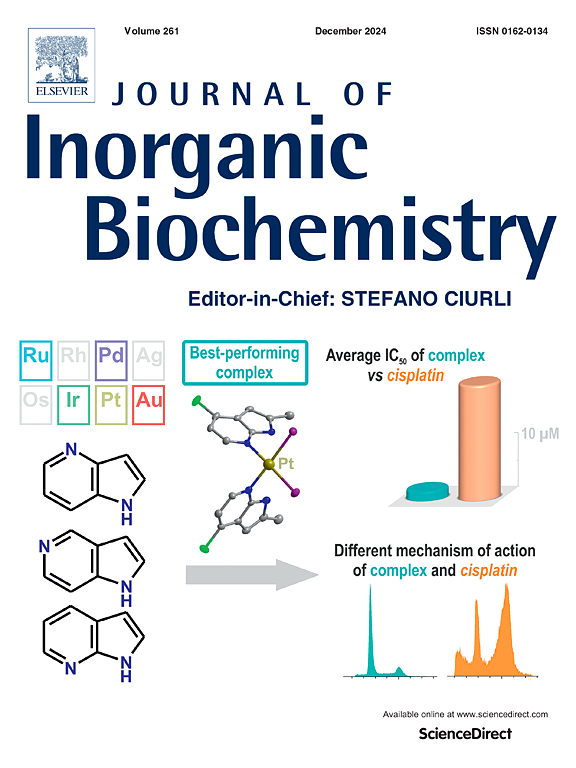[FeFe]氢化酶的仿生学:偶氮偶铁与氧二苯基丙二硫酸盐配合物与单膦与二膦
IF 3.2
2区 化学
Q2 BIOCHEMISTRY & MOLECULAR BIOLOGY
引用次数: 0
摘要
为了广泛开发[FeFe]氢化酶的生物启发化学,本研究深入研究了全羰基二铁偶氮-与氧二苯基丙二硫酸盐前体Fe2(μ-Ph2xdt)(CO)6 (Ph2xdt = Ph2odt = (SCHPh)2O为1,Ph2adtNH = (SCHPh)2NH为2)与单-与二膦P(C6H4R-p)3 (R = Me和Cl)和(Ph2P)2R ' (R ' =顺-CH=CH-为dppv和- ch2ch2 -为dppe)的选择性取代。以单膦为原料,用Me3NO·2H2O将1在MeCN中室温氧化脱碳,得到单取代双铁Ph2odt配合物Fe2(μ-Ph2odt)(CO)5){κ1-P(C6H4R-p)3} (R = Me, 1b = Cl);通过紫外(365 nm)辐照,得到了类似的Ph2adtNH二铁配合物Fe2(μ-Ph2adtNH)(CO)5){κ1-P(C6H4R-p)3} (R = Me为2a, Cl为2b)。以二膦为原料,用紫外光照射甲苯中1或2的脱碳反应制备了dppv螯合的二铁Ph2xdt配合物Fe2(μ-Ph2xdt)(CO)4(κ2-dppv) (Ph2xdt = Ph2odt, Ph2adtNH = 2c);通过me3no辅助1在室温MeCN中脱碳和2在回流甲苯中脱碳,分别合成了二铁螯合物Fe2(μ-Ph2xdt)(CO)4(κ2-dppe) (Ph2xdt = Ph2odt为1d, Ph2adtNH为2d)。利用元素分析、FT-IR和核磁共振(1H, 31P)光谱对这些新的二铁配合物的分子结构进行了全面的阐明,并利用x射线晶体学对1,2和1a, 2b进行了进一步的确认。研究了具有代表性的配合物1、1a、1c和2、2a、2c的电化学性能,并比较了它们在加入和不加入乙酸(AcOH)时的电化学性能。本文章由计算机程序翻译,如有差异,请以英文原文为准。
![Biomimics of [FeFe]‑hydrogenases: Diiron aza- versus oxadiphenylpropanedithiolate complexes with mono- versus diphosphines](https://img.booksci.cn/booksciimg/2025-2/101301243151770446593.jpg)
Biomimics of [FeFe]‑hydrogenases: Diiron aza- versus oxadiphenylpropanedithiolate complexes with mono- versus diphosphines
To extensively devolep the bioinspired chemistry of [FeFe]‑hydrogenases, this study performs an insigt into the selective substitution of all‑carbonyl diiron aza- versus oxadiphenylpropanedithiolate precursors Fe2(μ-Ph2xdt)(CO)6 (Ph2xdt = Ph2odt = (SCHPh)2O for 1 and Ph2adtNH = (SCHPh)2NH for 2) by mono- versus diphosphines P(C6H4R-p)3 (R = Me and Cl) and (Ph2P)2R′ (R′ = cis-CH=CH- for dppv and -CH2CH2- for dppe). With monophosphines, their monosubstituted diiron Ph2odt complexes Fe2(μ-Ph2odt)(CO)5){κ1-P(C6H4R-p)3} (R = Me for 1a and Cl for 1b) were obtained through the oxidative decarbonylating of 1 at room temperature in MeCN with Me3NO·2H2O; in contrast, analogous diiron Ph2adtNH complexes Fe2(μ-Ph2adtNH)(CO)5){κ1-P(C6H4R-p)3} (R = Me for 2a and Cl for 2b) were afforded via the photolytic decarbonlating of 2 under UV irradiation (365 nm) in toluene. With diphosphines, the dppv-chelated diiron Ph2xdt complexes Fe2(μ-Ph2xdt)(CO)4(κ2-dppv) (Ph2xdt = Ph2odt for 1c and Ph2adtNH for 2c) were prepared from the UV-irradiated decarbonylation of 1 or 2 in toluene; by contrast, the dppe-chelated diiron similar complexes Fe2(μ-Ph2xdt)(CO)4(κ2-dppe) (Ph2xdt = Ph2odt for 1d and Ph2adtNH for 2d) were synthesized from the Me3NO-assisted decarbonylation of 1 in room-temperature MeCN and that of 2 at refluxing toluene, respectively. The elemental analysis, FT-IR and NMR (1H, 31P) spectroscopy are used for the full elucidation of the molecular structures of these new diiron complexes and X-ray crystallography is applied for further confirmation of 1, 2 and 1a, 2b. The electrochemical properties of representative complexes 1, 1a, 1c and 2, 2a, 2c have been explored and compared with and without acetic acid (AcOH).
求助全文
通过发布文献求助,成功后即可免费获取论文全文。
去求助
来源期刊

Journal of Inorganic Biochemistry
生物-生化与分子生物学
CiteScore
7.00
自引率
10.30%
发文量
336
审稿时长
41 days
期刊介绍:
The Journal of Inorganic Biochemistry is an established international forum for research in all aspects of Biological Inorganic Chemistry. Original papers of a high scientific level are published in the form of Articles (full length papers), Short Communications, Focused Reviews and Bioinorganic Methods. Topics include: the chemistry, structure and function of metalloenzymes; the interaction of inorganic ions and molecules with proteins and nucleic acids; the synthesis and properties of coordination complexes of biological interest including both structural and functional model systems; the function of metal- containing systems in the regulation of gene expression; the role of metals in medicine; the application of spectroscopic methods to determine the structure of metallobiomolecules; the preparation and characterization of metal-based biomaterials; and related systems. The emphasis of the Journal is on the structure and mechanism of action of metallobiomolecules.
 求助内容:
求助内容: 应助结果提醒方式:
应助结果提醒方式:


